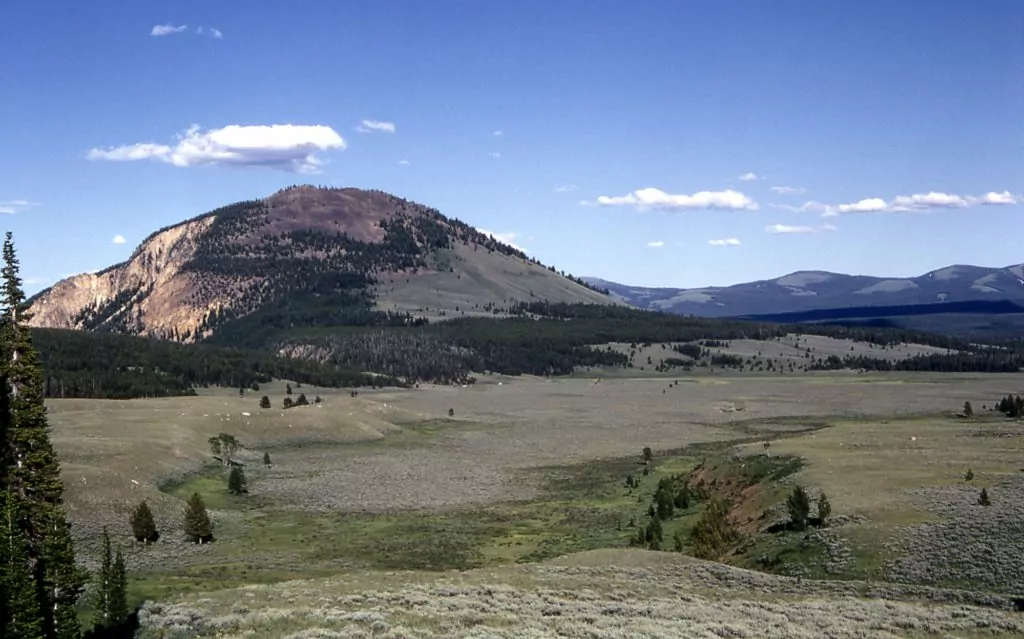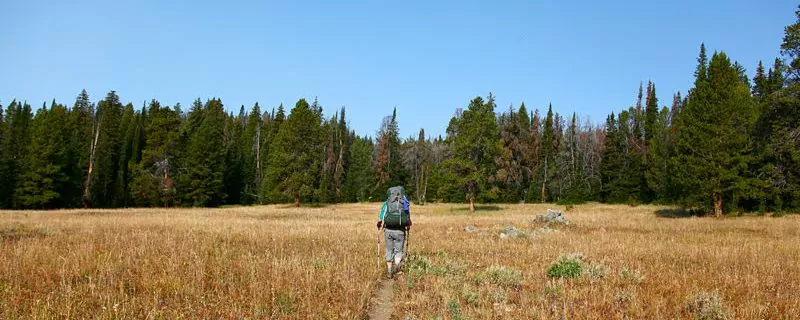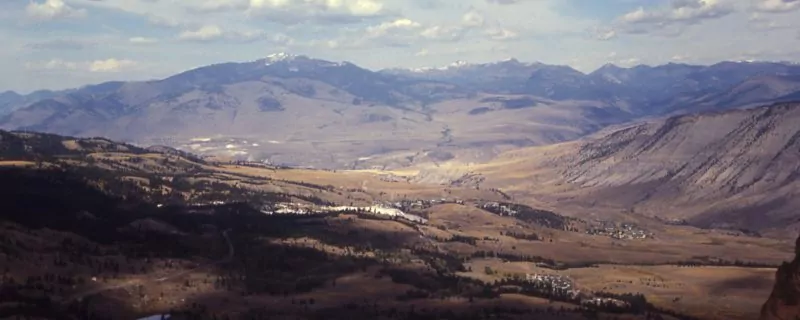
Bunsen Peak Trail
General Description
The Bunsen Peak trail is a well-signed, moderate march up the remains of a volcano to a summit with spectacular 360 degree views of Yellowstone’s Northern range. From the top, you can admire the Gallatin mountain range, Swan Lake Flats, Mammoth Hot Springs, Fort Yellowstone, Everts Bluff, and the Yellowstone River Valley. Great views pop up along the trail too in between Lodgepole forests, burn areas, wildflowers, and glimpses of unique geology.
Explore Yellowstone with Expert Guides
Getting to the Bunsen Peak Trailhead
The Bunsen Peak Trailhead is located on Grand Loop Road, 5 miles south of the Mammoth Hot Springs area. The parking lot is across the road from the Glen Creek Trailhead. Click here for directions to the parking area. There are no restrooms or water at the trailhead or on the trail. The nearest potable water is located at the Mammoth Hot Springs Visitor Center.
History of the Bunsen Peak Trail
This peak was first ascended during the famous Hayden Expedition of 1871 by Ferdinand V. Hayden and Captain John W. Barlow. Hayden, the head of the US Geological and Geographical Survey of the Territories and Barlow leading the US Army Corp of Engineers’ own survey combined their efforts on this expedition to give us the inception of formal history in Yellowstone. The records, stories, photographs, and art produced from their exploration corroborated the tales of mountain men and first nations from decades past. With proof of Yellowstone’s wonders, the country started to take notice and the road to creating the World’s 1st National Park began.
A proper name for this peak did not stick until years after the first ascent. The honor was given to the renowned inventor of the bunsen burner, Robert Bunsen. The connection came from the German chemist’s lesser known accomplishments in the study of volcanic geyser theories. Much of the groundwork he laid remains true in the modern understanding of geyser science. This truly was a symbolic namesake however, as Robert Bunsen studied the geysers of Iceland and never visited Yellowstone.
3 Best Day Hikes on the Bunsen Peak Trail
Hiking Bunsen Peak can be done with a few variations once you reach the summit.
Below are the primary options for day hiking the Bunsen Peak Trail:
| Destination | Miles | Elev | Difficulty | Style | |
| Bunsen Peak Out and Back | 4.6 mi | 1285 ft | Moderate | Out and Back | |
| Bunsen Peak Loop | 7 mi | 1285 ft | Moderate | Loop | |
| Bunsen Peak + Osprey Falls | 9 mi | 1985 ft | Strenuous | Loop |
1. Bunsen Peak Out and Back
The best way to ascend Bunsen Peak is from the North side, listed as 2.1 miles at the trailhead. Going up and back down this trail is the fastest and most common way to do this hike. The path is well-maintained and easily distinguishable. This route will take most people 2-3 hours.
You will start off gradually scaling the lower slope of the mountain through many Lodgepole pines and a smattering of Lupines alongside you. Aerial views of the canyon you drove through to get to the trailhead, known as the Golden Gate, will appear on your left. Geology buffs should look out for the columnar basalt at the top of Terrace Mountain and the ghostly shaped travertine, called the hoodoos, in the canyon below.
After almost a mile, the trail wraps around the southwest side of the mountain revealing wide open views of Swan Lake Flats, Gardners Hole, and the Gallatin Range. From here, photos of Electric Peak, Antler Peak, and Quadrant Mountain will stand out even better than they would from the summit. Next, the trail reverts back to the North side through a burn area from the historic Summer of Fire in 1988. Be on the lookout for plant life such as Fireweed, Indian Paintbrush, and Whortleberries. At 1.4 miles the trail will bend at a picturesque corner that drops off before a spire known as Cathedral Rock. The spot provides great vantage for pictures of Mammoth Hot Springs, Fort Yellowstone, and Everts Bluff.
From this corner, the switchbacks will tighten and the climb will intensify. The ground below you will change from firm soil to shifting talus. The path can be a bit harder to recognize with this ground cover. Pay attention not to cut the switch backs so that your impact is confined to the proper trail. You’ll know you’re close when you see powerlines stretching above your head. The 2.1 miles indicated on the trail signs will reach the weather station hut, which offers a great covered patio for shelter from the elements. The full 2.3 mile trail will take you past the hut to the true summit of Bunsen, a slightly higher mound marked by a USGS cement stump. From this point, the spectacular 360 degree views are unbeatable. To complete your hike, turn back the way you came, and enjoy the trail views once again.
2. Bunsen Peak Loop
Add variety and mileage to your day on Bunsen Peak by taking an alternate trail to get from the summit back to the trailhead.
Follow everything from the description above, as the main trail is still the most exciting way to start the hike. Once you are done basking in the views from the summit, follow a well-defined trail down the Northeast side of the peak. From this vantage, the views expand from Fort Yellowstone, Everts Bluff, and the Yellowstone River Valley to the Blacktail Plateau. To the south, you’ll even get a decent view of Sheepeater Canyon created by the Gardner River, the well-hidden location of Osprey Falls. Follow the trail 2 miles down steep switchbacks through a burn area that covers nearly the whole eastern side of the mountain. The lack of foliage keeps the views consistently open and enjoyable.
At the end of the slope, you will reach a wide flat trail, the remnants of an old wagon road that skirts about half way around the bottom of the mountain. Take a right and follow this pleasant 3-mile walk on Bunsen Peak Road back to the trail head. Keep a lookout for cyclists, as this is one of the few trails in the Park they are allowed on. This route is 7 miles and takes about 3-5 hours.
3. Bunsen Peak + Osprey Falls
This route combines an awe-inspiring summit with a descent into one of Yellowstone’s deepest canyons and a secluded waterfall. If you have the time and strength for a 9-mile day with almost 2,000 feet of elevation gain/loss, this is definitely the most rewarding route.
Follow the trail description above until you reach the flat Bunsen Peak Road trail. Across the road, at this very junction, you will see a sign that says Osprey Falls Trail. Heed the warning about what a steep and narrow path it will be. You descend 700 feet in about 1 mile. The first quarter of a mile leads you across the canyon rim with great views down below. From there, you’ll follow tight switchbacks until you reach the river. Erosion has shaped sharp pinnacles in the limestone along the canyon walls above you. Follow the trail atop a small hill to get a full-frontal view of the 150-foot Osprey Falls. As it is a lesser known gem, chances are good that you will have this waterfall all to yourself.
Beware, the strenuous climb out of the canyon will come when your legs are most tired from the day. Return back the way you came. Once you reach the junction with Bunsen Peak Road, take a left and follow the flat 3-mile path back to the trailhead. This route can take about 4.5 to 7 hours.
If Osprey Falls is your only goal for the day, simply take the Bunsen Peak Road trail to and from the Osprey Falls trail for a moderate 8-mile hike.
Maximize Your Visit to Yellowstone National Park on a Hiking Tour
Guided day hike tours and multi-day packages allow visitors the opportunity to make the most of their time in Yellowstone National Park and to do it hassle-free. Guided tours include gear (backpack, trekking poles, crampons in winter), meals, accommodations on multi-day tours, local transportation, and a professional Yellowstone hiking guide. Through their knowledge, stories, and personal passion, guides can bring a place to life in a way that’s much more difficult to do on your own. Read more about Yellowstone Hiking Tours.
Award Winning USA Hiking Vacations

When to Hike and Seasonal Considerations
Bunsen Peak is best enjoyed June through August. The trails are accessible and wildflowers are blooming. The peak is often doable in May but might have too much snow. If making an early season attempt, consider bringing footwear traction devices, such as Microspikes by Kahtoola, for safety when encountering icy slopes. A September visit is also lovely. You trade bright wildflowers for fall colors and chances of watching wildlife down below are greater.
Weather can change drastically at any time in Yellowstone. Always check the forecast at the start of your hike. Pack proper layers for wind, rain, and cold. The summit of Bunsen Peak is not a good place to be in a thunderstorm.
Another condition to consider is fire. If there are active fires in the area, views will be hazy and air quality poor at the summit. Consider saving Bunsen for a clear day in fire season.
We do not recommend attempting Bunsen Peak in Winter (November-April). For most hikers, the safety risks would be tremendous, the trail inconvenient or expensive to access, and the physical difficulty would outweigh the enjoyment. If you are interested in hiking in the mountains during extreme winter conditions, make sure to educate yourself on how to travel in avalanche terrain. A good resource for this is “Know Before You Go”. kbyg.org
Animal Safety
Wildlife is one of the best reasons to visit Yellowstone. With the privilege of hiking through their habitat comes great responsibility to uphold respect and safety. Becoming accustomed to humans is not good for the well-being of any wild animal. Even our docile herbivores can maim or kill people. The key to these guidelines is to just let the animals be.
- Never feed wildlife (Not even a squirrel)
- Do not approach wildlife
- Stay at least 100 yards away from bears and wolves
- Stay at least 25 yards away from all other animals
- Do not shout, whistle, or otherwise harass wildlife
If you want to view wildlife from the road, always stop in a designated pull out.
Bear Safety
Yellowstone is black and grizzly bear country. Special practices are necessary to improve the safety of yourself, other visitors, and the animals. Most of these tactics aim to avoid making a bear react defensively. A bear will feel threatened if we surprise it, approach its cubs, or encroach on its food source. We must also do everything in our power to prevent a bear from eating human food or smelling an attractant where we sleep.
While Hiking
All of the following practices are necessary whether you are hiking in bear country for 5 minutes or 5 days.
- Don’t hike alone (At least 3 people is best)
- Always be alert
- Make noise
- Carry bear spray and know how to use it
- Never feed a bear
- Do not leave packs or any food unattended
- Stay on maintained trails
- Avoid carcasses
- Avoid hiking at dawn, dusk, or night
- Stay out of areas closed for bear management
Bear Encounters
As the park service says, safety cannot be guaranteed in these wild places. These are best practices to lower the risks of an aggressive bear encounter.
- Do not run
- Slowly back away (taking any food with you)
- Speak calmly, do not shout
- Group together, make yourselves look large
- When necessary, use bear spray
- Report conflicts to park rangers
Check out Yellowstone National Park’s great reference on how and when to use bear spray.
Necessary Permits
Day Hike Permits
There are no permits required to do any day hiking in Yellowstone National Park. However, some areas can be closed to due high bear activity. Before you head out, you can check to see which Bear Management Areas are closed by clicking here.
Suggested Packing List
Day Hike Packing List
- bear spray
- 2-3 liters of water
- salty, calorie-rich snacks
- lunch
- backpack
- trekking poles
- wide-brimmed hat
- sunscreen, sunglasses
- bug spray
- non-cotton hiking shirt
- rain jacket
- warm non-cotton layer
- 1st-aid kit
Please Respect Our National Parks – Leave No Trace
We strongly recommend abiding by all Leave No Trace ethics guidelines and practices so that our national parks and public lands are preserved for the enjoyment of future generations and for the people and animals who call these places home. Simple things like packing out your trash, obeying national park rules, and respecting the peace and quiet of our national park trails is a great start. If you’re going on a backpacking trip, you can read about more about the 7 Leave No Trace Principles.





